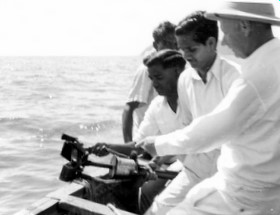Contributing to the Compendium
Importing data into the Compendium:
Our goal for the Compendium is to make it a community project, such that authorized users can upload and maintain their own data. Up to this point however, importing data is still a manual process done by the website maintainer. Contributors can email spreadsheets, professional bio, and any other content to Dr. Subba Rao Durvasula (seshu35@gmail.com).
The checklist format for submitting data to the Compendium is easy to use. Two spreadsheet tables are needed: one for species data, and one for corresponding references data. The two tables can be in one spreadsheet file, or two files (preferred). Species are linked to one or more references by a Reference number. The spreadsheets can be in any normal format, including Microsoft (.xls, .xlsx), OpenOffice/LibreOffice (.ods), and CSV text.
Species and references data should be separated into the following fields:
Species fields:
- rank1 (e.g. superkingdom)
- rank2
- ...
- rankN (e.g. subspecies)
- Host(s) (if any)
- Common name(s)
- Occurrence(s)
- Authority
- Note(s) (if any)
- Reference number(s)
Reference fields:
- Reference number
- The entire reference in publication format (below).
The species table field order above is preferred, but not required. There is also no requirement on the number of species table fields. A large or complete set of ranks is desirable. Please separate values in a multi-valued field with commas, e.g. Reference numbers: 1,3,22.
The Compendium presently has rank and sub-rank columns, e.g. Phylum and Subphylum. A future version will also accommodate 'super-' and 'infra-' classifications.
The publication format is:
Author1, A.B., Author2, C.D., and Author3, E.F. yyyy. Title. Publication.
(yyyy = year, e.g. 2011)
Examples:
Das, S.M. 1936. Herdmania (The monascidian of the Indian seas). Indian Zoological Memoirs. No. 5. Lucknow.
Renganathan, T.K and Krishnaswamy, S. 1985. Some colonial ascidians from Indian waters. Indian J. Mar. Sci. 14: 38-41.
The "architecture" of a spreadsheet:
- Species and reference records each occupy a single row.
- Each field occupies a single column.
- Please do not use neighboring spreadsheet cells to continue a field data item (A very large amount of text will fit in one cell.)
- Please do not use a single column for multiple taxonomic ranks.
- Please fill in known taxa for a rank (even if a taxon is repeated many times). Blank cells indicate no data given.
- Note that some species field data may contain several values, e.g. several reference numbers, separated by commas (in a single spreadsheet cell.)
- For references, please provide all of Author, Year, Title, Publication - if unknown, enter "n/a".
- Preferred author name format: 'LastName(s), A.B.', instead of 'A.B. LastNames(s)'.
Sample rows of a checklist Species table:
| Superkingdom | Kingdom | Phylum | Class | Order | Family | Genus | Species | Occurrence | Authority | Ref_num |
|---|---|---|---|---|---|---|---|---|---|---|
| Eukaryota | Animalia | Nematoda | Adenophorea | Enoplida | Ironidae | Trissonchulus | oceanus | Bay of Bengal | Cobb, 1920 | 2,9 |
| Eukaryota | Animalia | Nematoda | Adenophorea | Enoplida | Oxystominidae | Halalaimus | setosus | Bay of Bengal | Timm, 1961 | 1 |
Sample rows of a checklist References table:
| Ref_num | Reference |
|---|---|
| 1 | Chandrasekhara Rao G. 1963. Studies on marine interstitial fauna inhabiting the sandy beaches of Waltair coast. Andhra University, Unpublished. |
| 2 | Chinnadurai, G. and Fernando, O.J. 2006. Meiofauna of mangroves of the southeast coast of India with special reference to the free-living marine nematode assemblage. Published in Estuarine, Coastal and Shelf Science (2006), pp-1-8. |
| 9 | Sultan Ali, M.A. et al. 1998. Nematodes of Pitchavaram Mangroves. Published in GIS based information system for Pichavaram, Govt of India (1998), pp:1-47. |
